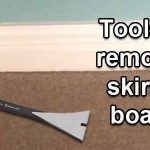When fixing skirting boards to walls, it is best practice to use a combination of adhesive and mechanical fixings.
The best adhesive for skirting boards is a general grab adhesive. This gives you a number of different brands to choose from, and the price range can vary significantly.
However, a cheap adhesive, such as Gripfill (green tube) or Pinkgrip is all you need, you can pick these up for between £3 and £4 per tube and they will give you a very good fixing.
There is no need to pay £10+ for more expensive brands like No More Nails or Sticks Like Sh*t. Whilst these are decent products, they aren’t any stronger when used for this job.

Usually, there isn’t a large amount of force trying to pull skirting away from the wall anyway. Therefore, paying 3-4 times as much for an adhesive, is completely unnecessary, especially considering they aren’t much stronger (if at all).
Another alternative that some people like to use, is adhesive foam. Whilst this will do the job, it is another expensive product, and it will usually cost around 4 x as much as a tube of Gripfill. Not only that, but it can be much messier than a standard grab adhesive.
Mechanical fixings used with skirting boards
For the mechanical fixings, you have a few different options:
- Nail manually with small oval or lost head nails
- Screw in place
- Or use a 2nd fix nail gun
The fixing you choose, will depend on the surface you are fixing too. For example, a stud wall could be fixed with any of the above.
If on the other hand, you are fixing to a solid wall, then you may need to drill into the wall through the skirting and fix with plugs and screws. This will give a stronger fixing.
In some instances, you can also use a nail gun on solid walls. Generally, you would use shorter brads for this method. These would penetrate the plaster on top of the masonry, but they wouldn’t be long enough to hit the masonry and curve back out the front of your skirting board.
Manual nailing is less common. However, if you need small fixing holes and don’t have a nail gun, this could be your best option. This might be the case, if you are fitting solid wood skirting that will have a stained finish. Nail holes are much easier to hide than a big screw hole.
Another adhesive you NEED with skirting
A grab adhesive is used on the back of your skirting. However, you also need to consider the joints. These are the mitres and scribes where one piece of skirting board is joined to another. You should ensure these are fixed together securely.
By fixing the joints, you will avoid gaps forming in the future. This can happen due to movement over time, as well as expansion and contraction due to changes in humidity and moisture.
However, gluing these joints is not the job of a grab adhesive. Instead you should use a standard wood glue. Or another popular option is a 2-part mitre adhesive. A good example of this, is Mitre Fast.
This type of product combines a glue and an activator spray. Simply apply the glue on one side and the spray on the other and push them together. At this point, you have around 10 seconds to align them correctly and the glue will set solid.
A 2-part mitre adhesive will cost you less than £10. You can see some more details on Mitre Fast, as well as customer reviews by clicking here.
A standard wood glue will cost you a similar amount and will also give a strong bond once dried. The main advantage with a two-part mitre adhesive, is the speed it dries. This can be good if there is a small gap that needs closing. With the two-part adhesive, you can hold it for 10 seconds and it will fix solid. On the other hand, with a wood glue, the drying time is much slower.
Can you fix skirting with just adhesive
In theory, skirting boards can be fixed with just adhesive. However, it is not best practice, and you will have a weaker bond with the surface. For this reason, it is recommended that you use a combination of adhesive and mechanical fixings wherever possible.
Most grab adhesives are very strong, if skirting boards are applied correctly, and the wall is relatively straight, there is not much force to pull the boards away. However, it can happen and if the adhesive fails you will end up with gaps between your skirting board and wall.
In most cases, adding additional fixings isn’t much extra work. Especially if you are fixing the skirting boards with a nail gun. In this case, you can fire a couple of nails every few hundred mm and this will add plenty of extra grab.
You can learn more about the best type of nail gun for skirting boards by clicking here
However, there are some cases where you may want to avoid fixings. For example, if you are fitting to a wall, where you know pipes are present below the surface. In this case, it may be better to avoid any nails or screws. This will avoid the risk of hitting a pipe and causing a leak.
Conclusion
The best adhesive for skirting boards is a highly debated topic. There are literally dozens of options available. However, over many years, I have personally used all of the popular brands and a £3 tube of Gripfill, or Pinkgrip is hard to beat.
Where possible you should use a grab adhesive in combination with mechanical fixings. Also, don’t neglect your mitres and scribes, as these will also need a separate adhesive to fix them together securely.



